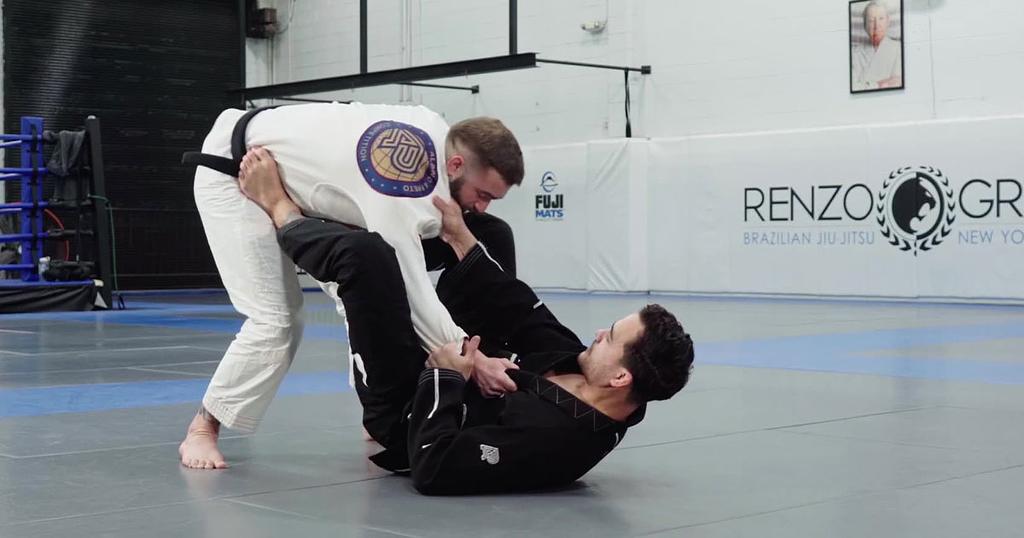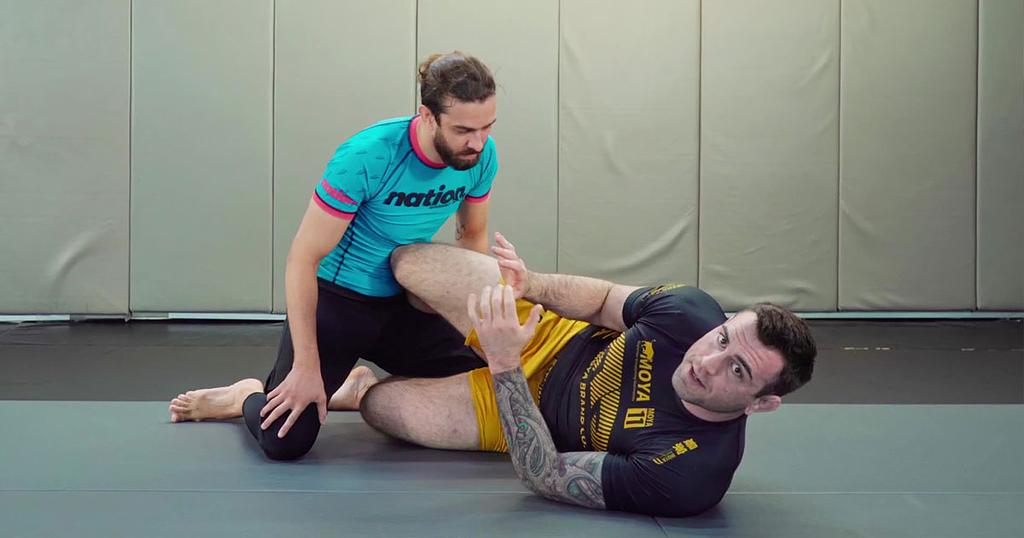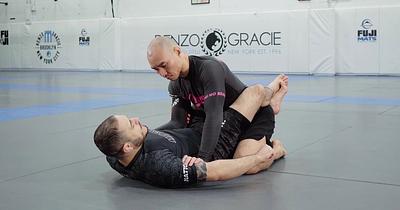Closed Guard Overview
by Team Digitsu
Updated: March 24, 2025

In Brazilian Jiu-Jitsu (BJJ), the closed guard is a fundamental position that puts you at a strategic advantage when executed effectively. As a staple in martial arts, particularly in BJJ, it involves wrapping your legs around your opponent's waist with your ankles crossed, effectively controlling their posture and movements. This position is your gateway to a multitude of offensive techniques and can serve as a robust defensive platform, ensuring that you're well-prepared for various situations on the mat.
Understanding the mechanics of the closed guard is crucial as it lays the groundwork for your progression in BJJ. While it might seem that having an opponent on top puts them in an advantageous position, the reality within the closed guard dynamic is quite the opposite. Here, you harness the ability to neutralize their gravitational benefit and set up submissions, sweeps, or transitions to more advantageous positions. It is a fertile ground for creativity and adaptation, allowing you to tailor your approach to the specific context of the bout.
Mastering the closed guard is an endeavour that requires patience, practice, and a deep understanding of the principles that underpin this multifaceted position. As you go deeper into BJJ, refining your closed guard will not only fortify your defense but also elevate your offensive tactics, making it an essential component in your BJJ toolkit. Whether you're a beginner looking to establish a solid foundation or an advanced practitioner aiming to fine-tune your strategy, the closed guard remains a critical element in the vast landscape of BJJ.
Understanding Closed Guard in BJJ
Mastering the closed guard is essential, as it is not only a fundamental position but also a point from which numerous attacks can be launched.
The Position and Its Significance
The closed guard, also known as full guard, is when you are on your back and your legs are wrapped around your opponent's torso with your ankles locked. This is a dominant position that allows you to control your opponent while opening up opportunities for submissions and sweeps. Properly executed, it neutralizes many of your opponent's offensive moves and puts you in a tactical position to advance or defend effectively.
Differences Between Gi and No-Gi
In gi BJJ, the closed guard becomes a stronghold due to additional grip options provided by the gi. You can use the lapels, sleeves, or belt to control the opponent, making it more challenging for them to escape or pass your guard. On the other hand, no-gi BJJ demands a focus on overhooks, underhooks, and body clinching as you lack fabric grips. Your control in no-gi is more reliant on physical hooks and friction. Despite these differences, the closed guard remains a staple in both forms, fundamental to your defensive and offensive BJJ strategy.
Mastering the Fundamentals
A solid grasp of the closed guard's fundamentals is crucial for your progression, especially as a beginner or white belt. Understanding the nuances of posture, base, and maintaining control in this position will serve as the cornerstone of your defensive and offensive capabilities on the mat.
Posture and Base
A strong posture is your first line of defense in the closed guard. As a beginner, it's imperative to focus on keeping your back straight and head up, resisting the temptation to lean forward. Proper base involves sitting back on your heels with your knees pinning tightly against your partner’s sides, which provides stability and makes it harder for them to unbalance you or attempt sweeps.
-
Posture:
- Keep your back straight
- Maintain your head up
-
Base:
- Sit back on your heels
- Pin your knees against your partner’s sides
Guard Control and Maintenance
To maintain control while in someone's closed guard, your hands play a critical role. Always be mindful of where you place your hands; one common approach is positioning one hand on the opponent’s belt and the other on their sternum or bicep to prevent them from sitting up or attacking. Cultivate an awareness of your opponent's movements, and adjust your grips and pressure accordingly to keep the guard closed and thwart their attempts to escape or submit you.
-
Hand Placement:
- One hand on the opponent’s belt
- Another hand on their sternum or bicep
-
Maintaining Control:
- Adjust your grips based on opponent's movements
- Apply pressure to keep the guard closed
Essential Closed Guard Submissions
The closed guard is a dominant position in BJJ that allows you to control your opponent and launch a variety of submissions. Mastering a few key attacks from this position can significantly enhance your ground game.
Armbar Techniques
To execute an armbar from the closed guard, start by creating an angle with your body. Secure your opponent’s wrist and pivot your hips outward, sliding your leg up and over their head. Clamp your heels down and ensure your knees are tight around the arm before arching your hips upward to finish the submission.
Triangle Choke Application
For a successful triangle choke, your setup must include pulling your opponent's arm across their body and securing it. Shoot your leg up over their trapped arm and across their neck, locking your foot behind your opposite knee. Adjust the angle by grabbing your opponent's leg, creating the necessary leverage to apply pressure and complete the choke.
Executing the Kimura
When your opponent's hand is on the mat, you have an opportunity to attack with a kimura. Grip their wrist and use your opposite arm to loop over their arm, grabbing your own wrist to form a figure-four grip. Turn your hips towards their trapped arm and elevate your opponent's elbow while pulling their wrist towards their head to lock in the submission.
Effective Sweeping Strategies
Sweeping from closed guard is a fundamental skill that can turn the tide of a match by reversing positions. Knowing a few key sweeps and their mechanics will significantly boost your ground game efficiency.
Hip Bump Sweep Fundamentals
The Hip Bump Sweep relies on timing and momentum. Begin by creating an angle and when your opponent's hand touches the mat, sit up by propping on your arm, simultaneously swing your hips and bump your opponent’s chest with your shoulder to knock them off balance and complete the sweep. This maneuver transitions you from the bottom to a dominant top position. The sweep is super simple, and works well against opponents who are not familiar with it. The keys to successful are getting past your opponents head and hands, and works well in combination off of other sweeps.
Scissor and Pendulum Sweeps
Two essential sweeps from closed guard are the Scissor Sweep and Pendulum Sweep. For the Scissor Sweep, you need to:
- Obtain a sleeve and collar grip.
- Place one foot on the opponent's hip, and slice your other leg across their body.
- Chop their leg out from under them while pulling with your grips.
The Pendulum Sweep adds a dynamic element:
- Shift your body to the side, controlling one of your opponent's arms.
- Swing your leg like a pendulum to gain momentum.
- Underhook their leg to facilitate flipping them over.
Advanced Flower Sweep
Elevate your sweeping game with the Flower Sweep. This involves:
- Securing a sleeve grip and an opposite arm underhook.
- Opening your guard, you place a foot on the mat to generate leverage.
- By lifting your hips and twisting, sweep your opponent over the secured arm.
Each of these sweeps, the hip bump, scissor, pendulum, and flower, are effective strategies that enable you from closed guard to gain advantageous positions. Practice to make these sweeps instinctive for your BJJ repertoire.
Closed Guard for Self-Defense
The closed guard is a fundamental position that enhances your self-defense capabilities. It serves as a robust defensive posture that can neutralize a larger opponent.
Using Closed Guard in Real Situations
When you find yourself on the ground in a self-defense scenario, employing the closed guard can be crucial. By wrapping your legs around your attacker, you create a barrier that limits their mobility and ability to cause harm. In practice, the closed guard allows you to control an assailant and strategize an escape or counter-attack. It is a position often drilled in MMA and BJJ due to its practical applications in real confrontations.
Defense Against Strikes
Now, defending against strikes from the closed guard involves using your legs and arms to create a shield. Your primary objective is to prevent the opponent from gaining posture and initiating powerful strikes. Here are a few methods to fortify your defense:
- Use your legs to pull the attacker close, minimizing the space they have to generate force.
- Employ your arms to control their arms, which disrupts their ability to land effective hits.
- In MMA, athletes often use a combination of grips on the clothing or body, along with hip movement, to redirect and stifle incoming punches or elbows.
Practicing these techniques in a controlled environment ensures that you are prepared to use the closed guard effectively for self-defense. The early UFCs with Royce gracie are a great demonstration of how to use the closed guard to defend yourself from strikes and when the fight from the bottom. Keep in mind, in the early UFC ruleset there were less rules and even headbutts were allowed.
Training and Improvement
As you embark on your BJJ journey, understanding the training strategies and drills that can enhance your closed guard is crucial. Progression in BJJ is marked by many factors, and how you train can make the difference between a stagnant practice and a flourishing skillset.
Progressing from White to Black Belt
During your transition from white to black belt, your closed guard will evolve dramatically. As a beginner, focus on fundamentals—practicing basic grips and hip movement to maintain a dynamic guard. Roger Gracie exemplifies the power of a strong closed guard, where even the simplest sweeps and submissions are executed flawlessly. Higher belts should examine detailed techniques and variations, analyzing matches of Kron Gracie for practical application. Closed Guard is a common guard to start out learning in BJJ. This is because it allows you to slow the pace down, your opponent has to unlock your legs before they can move forward and advance their position. It also works well in self-defense and MMA situations.
-
White Belt: Master basic setups and submissions; emphasis on survival and control.
- Example: Practicing the hip bump sweep and triangle choke repetitively.
-
Blue Belt: Develop transition flows between submissions; focus on guard retention.
- Example: Learning to flow from an armbar attempt to a sweep.
-
Purple Belt: Fine-tune techniques and start developing your unique style.
- Example: Adapting Roger Gracie's cross-collar choke to your game.
-
Brown Belt: Perfect your timing and explore advanced grips and setups.
- Example: Analyzing Kron Gracie's fights for grip strategies.
-
Black Belt: Innovate within the closed guard; train to handle any situation.
- Example: Sparring with various practitioner levels to challenge adaptability.
Incorporating Flow Drills
Flow drills play a pivotal role in improving your closed guard. They help you understand the rhythm of movements and transitions, making your guard work proactive rather than reactive. Begin with simple drills, such as switching hips or moving from closed guard to a sweep, before advancing to more complex flows.
-
For Beginners: Start with partner drills focusing on hip escapes and transitions.
- Drill: Partner stands, you practice switching from closed guard to hook sweep.
-
For Seasoned Practitioners: Incorporate unpredictable movements to simulate live rolling.
- Drill: Free-flow sparring starting in closed guard, focusing on chains of attacks rather than single techniques.
Remember: Consistency is key in your training. Whether it's drilling the same sweep from closed guard several times a week or methodically studying the strategic choices of elite players, your growth in BJJ will be a direct result of your dedicated practice.
Influential Practitioners and Systems
When exploring the closed guard in Brazilian Jiu-Jitsu, you'll find that certain individuals and their systems have had a profound impact on how this position is understood and applied. One exemplary figures stand out: Roger Gracie. His approach has shaped the way practitioners employ the closed guard as a dynamic and controlling position.
The Legacy of Roger Gracie
Roger Gracie, a name synonymous with the closed guard in BJJ, effectively showcased the power and control achievable from this position. With his impeccable technique, Roger Gracie displayed how the closed guard serves as a formidable platform to implement attacks. His mastery over the fundamentals—coupled with a keen understanding of the principles governing BJJ—served as a blueprint for many practitioners aiming to elevate their closed guard game. His approach emphasizes maintaining a connection with the opponent, focusing on how to:
- Maintain Control: Using your legs and grip to manage the distance and control the opponent's posture.
- Implement Attacks: Seamlessly transitioning to submissions such as arm bars and chokes.
Transitioning to Other Guards
When you're in closed guard, your goal is often to create opportunities for attacks or to transition to another guard that may offer more offensive options. Understanding how to fluidly move between different guards can greatly enhance your BJJ game.
Open Guard Transitions

To transition from a closed guard to an open guard, you'll first need to establish control over your opponent’s sleeves or wrists. This is essential in preventing them from passing your guard. Once control is secured, you can open your guard by uncrossing your legs. From here, shift your hips and place your feet on your opponent's hips, creating the space necessary to maneuver into various open guard positions, such as the spider guard, where you use your legs and arms to control your opponent's limbs, adding layers of complexity and control to your guard game.
Advancing to Half and Butterfly Guards

Moving to a half-guard involves allowing one of your opponent’s legs between yours while retaining control of the other leg. To achieve this, you need to manage the distance and timing to ensure you aren't giving up a dominant position. From half-guard, you can work on sweeps and submissions, or transition to a butterfly guard. In butterfly guard, sit up and use your hooks—created by placing the inside of your feet against the inside of your opponent's thighs—to lift and control their movement. Butterfly guard is particularly effective for executing sweeps because it allows you to disrupt your opponent’s balance easily.


